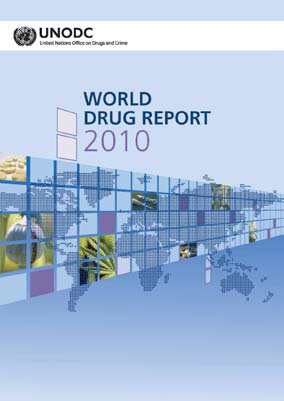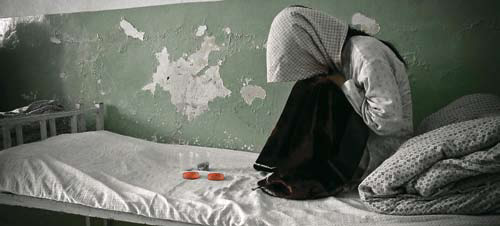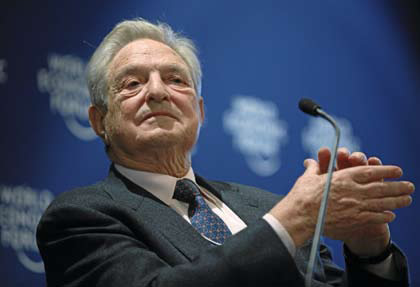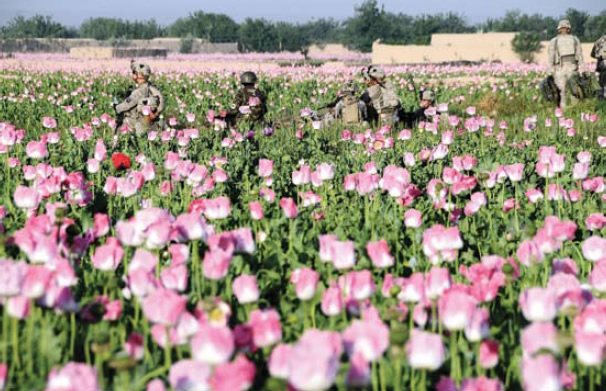1 Million Afghan Addicts
Cash-Starved Bankers and Terrorists
Keep Asia Narcotics Boom Going
by Ramtanu Maitra
July 2011
This article appears in the July 29, 2011 issue of Executive Intelligence Review and is reprinted with permision
 The UNODC Report deploys a myriad of statistics to claim that worldwide drug production and consumption have stabilized. But, the facts tell a different story. The UNODC Report deploys a myriad of statistics to claim that worldwide drug production and consumption have stabilized. But, the facts tell a different story. |
July 21—On June 23, the United Nations Office on Drugs and Crime (UNODC) released its World Drug Report 2010. Replete with data, the voluminous report (307 pages) gives the impression that drug production and consumption have stabilized. However, this could not be further from the truth.
In fact, what is happening today, due to the globalization and hot-money transfers that drive the drug trade, is an opening up of new drug-consumer markets among the drug-producer countries.
For example: Afghanistan, now flush with cash, shows a huge growth in the number of addicts. Deputy Counter-Narcotics Minister Mohammad Ibrahim Azhar estimates that at least 1 million Afghans, including a large number of women and children, are addicted to heroin. India, which is not far from Afghanistan, is also becoming an illicit producer and consumer of drugs. This new phenomenon spells real danger to the lives of hundreds of millions, in the same way that Britain's Opium War did in the 19th Century.
Equally important, but omitted from the UNODC report, is the reality that illicit, mind-destroying drugs have not only addicted millions of human beings, but fully hooked the corrupt, bankrupt financial system itself. Dope, Inc.'s illegal drug money is keeping the system afloat, while it funds the terrorism and arms traffic that the financial oligarchy uses to maintain control over the world's populations. The financial institutions which organize this drug money flow are buying up political figures who are becoming increasingly brazen in demanding legalization of their menticidal crimes. Unless this top-down financial reality is taken on, the drug- and crime-fighters at the UNODC will be helpless in defeating the drug scourge.
And UNODC head Antonio Maria Costa knows this.
The Banks Are Addicted to Drugs
In January 2009, by which time, the world financial system's collapse had become obvious even to the most short-sighted observer, Costa told the Austrian magazine Profil that drug money has been the only thing that has kept many major banks in business: "In many instances, drug money is currently the only liquid investment capital. In the second half of 2008, liquidity was the banking system's main problem and hence liquid capital became an important factor." Costa went on to say that the UNODC has discovered that "interbank loans were funded by money that originated from the drug trade and other illegal activities." He pointed to "signs that some banks were rescued in that way."
 Creative Commons/Jacksoncam Creative Commons/Jacksoncam Deputy Counter-Narcotics Minister Mohammad Ibrahim Azhar estimates that at least 1 million Afghans, including a large number of women and children, are addicted to heroin. Here, a woman opium addict at a detox center in Mazar-i-Sharif. |
It is evident that the world financial system is now in its death throes. Non-payable European sovereign debts of trillions of dollars have shaken up the European Union and the United States. The latter, under the Obama Administration, has gone so deeply into debt that it is teetering on the verge of default, while the Wall Street and City of London banks, which have created a new financial bubble, are now bankrupt and desperately looking for cash. Under the circumstances, as Costa pointed out earlier, a major cash-generating source for the banks is the drug traffic, which thrives on continuously expanding drug addiction.
Take the case of the Wachovia bank, which is now part of the Wells Fargo Company (WFC), one of the top five U.S. banks. Michael Smith of Bloomberg reported in June 2010, that Wachovia admitted it didn't do enough to spot illicit funds in handling $378.4 billion for Mexican currency-exchange houses from 2004 to 2007. That's the largest violation of the Bank Secrecy Act, an anti-money-laundering law, in U.S. history—a sum equal to one-third of Mexico's current gross domestic product. Wachovia was charged, but what happened? The bank paid $160 million in fines and penalties, and the company is now off the hook for further punishment.
One explantion is that President Obama's political campaigns, beginning with his run for the U.S. Senate in Illinois, were funded by the number one drug pusher in the United States: George Soros. Soros is also part of the drug-money dependent Wall Street elite. As Lyndon LaRouche recently noted, it was Soros's dirty money that brought Obama the White House.
Fallacy of Composition
According to the UNODC report, there has been a stagnation in production of narcotics because of a drop in production of opium in Afghanistan. Such a drop, about 30% of the peak value in 2007, occurred after Afghanistan's opium production went up 40-fold (!) between 2001 and 2008. In fact, in 2007, Afghanistan alone produced at least 3,000 tons more opium than the entire world's addicts could consume.
Following the U.S. invasion of Afghanistan, and after the poppy fields were transferred from Osama bin Laden's watch to the care of the British troops, Dawood Ibrahim, a major smuggler and former Mumbai mafia boss, became a transporter of drugs from Afghanistan to Dubai by means of his "mules," protected by the intelligence agencies and his beneficiaries. It is said that containers that carry large equipment to Dubai from Kandahar and elsewhere in southern Afghanistan for "repair," also contain drugs.
The drugs were converted to cash in Dubai. The tax-free island-city, sitting at a strategic crossroads of the Persian Gulf, South Asia, and Africa, is a major offshore banking center. With the development of the Dubai International Financial Centre (DIFC), the latest free-trade zone there, flexible and unrestricted offshore banking has become big business. Many of the world's largest banks already have a significant presence in Dubai: Abbey National Offshore, HSBC Offshore, ABN Amro, ANZ Grindlays, Banque Paribas, Banque de Caire, Barclays, Dresdner, and Merrill Lynch all have offices there.
 WEF/swiss-image.ch/Sebastian Derungs WEF/swiss-image.ch/Sebastian Derungs The world’s leading promotor of drug legalization, financier George Soros: It was his dirty money that bought the White House for Barack Obama. |
Outside of Dubai, most of the offshore banks are located in former British colonies, and all are involved in money laundering: Legitimizing cash generated from drug sales and other contraband for the "respectable banks" is the lifeblood of these offshore institutions. Arguably, the most important of the Caribbean offshore financial centers is the Cayman Islands, a British Overseas Territory run by a royal governor appointed by Queen Elizabeth II. The Caymans are mainly a mail drop and regulation-free zone, a place where hot money is welcome, and few questions are asked.
In 2001, a French parliamentary report exposed the connection between the drug money laundered by terrorist groups through the City of London. In a Guardian article Oct. 10, 2001, John Henley, citing an exhaustive 180-page French report, wrote that up to 40 companies, banks, and individuals based in Britain can legitimately be suspected of maintaining direct or indirect relations with the narcoterrorists. The report is based on interviews with senior Metropolitan Police officers, leading City financial regulators, and European judges investigating cross-border financial crimes in Spain, Belgium, and France.
According to a 70-page addendum, "The Economic Environment of Osama bin Laden," attached to the French report, compiled by an independent team of financial experts whose identity has not been revealed, the structure of bin Laden's financial network bears a striking similarity to that used by the collapsed BCCI bank for its fraudulent operations in the 1980s.
The report establishes numerous links between bin Laden and international arms and oil traders, and even members of the Saudi elite. It also pinpoints the relationship and its subsequent breakdown between bin Laden and his family's holding company, the Saudi Binladin Group, and its multiple subsidiaries, investments, and offshoots in Europe. The names of half a dozen former BCCI clients and officials, including Ghaith Pharaon, wanted by the U.S. authorities for fraud, and Khalid bin Mahfouz, a Saudi banker who was closely involved with the bank before it was closed down by the Bank of England in 1991, recur throughout the report, and are directly linked to Osama bin Laden through banks, holding companies, foundations, and charities, at least one of which, the International Development Foundation, is headquartered in London.
"This document clearly shows the great permeability of the British banking and financial system and the fragility of the controls operated at its points of entry," the French report concludes. A copy was obtained by the Guardian.
Many of the individuals concerned, several with British connections, were also involved in various senior roles with BCCI, the now-defunct drug bank set up in the 1970s, the report says. Hundreds of banks and companies are mentioned, from Sudan, Geneva, and London, to Oxford, the Bahamas, and Riyadh, Henley wrote.
"The convergence of financial and terrorist interests, apparent particularly in Great Britain and in Sudan, does not appear to have been an obstacle with regard to the objectives pursued [by bin Laden]," the report concludes. "The conjunction of a terrorist network attached to a vast financing structure is the dominant trait of operations conducted by bin Laden."
Less Production, More Addiction, More Cash
The World Drug Report 2010 does not deal with where the money goes and how it gets there. The report shows that drug use is shifting towards new drugs and new markets. It claimed that drug cultivation is declining in Afghanistan for opium. While last year's Afghan poppy crop was reportedly damaged by blight, the news from Afghanistan suggests that this year's crop is robust, and that opium production will show a significant jump over last year's harvest. Also, in Afghanistan, more and more provinces have taken up opium cultivation, unlike in 2007, when more than 50% of opium was produced in the southern province of Helmand. Cannabis production has also skyrocketed.
Opium production is moving northward in Afghanistan. Meanwhile, Soros and his Open Society Foundation have been extremely active over the years in the social and political scene in Central Asia—particularly in what are known as the "stan" countries. The objective of the drug lobby that Soros represents is the Ferghana Valley. With its abundant water and fertile soil, the valley sits between two potential large consumers—Russia and China. Moreover, the area, like southern Russia and western China, is full of terrorists who are sustained by the drug money.
The UNODC report says that drug (coca) cultivation in the Andean countries is declining, and drug use has stabilized in the developed world. However, there are signs of an increase in drug use in developing countries, and growing abuse of amphetamine-type stimulants (ATS) and prescription drugs around the world. It shows that the world's supply of the two main problem drugs—opiates and cocaine—continues to decline. Coca cultivation, down by 28% in the past decade, continued to decline in 2009. World cocaine production declined by 12-18% over the 2007-09 period.
 Creative Commons/isafmedia Creative Commons/isafmedia Afghanistan produces most of the world’s opiates, but seizes less than 2%, despite the presence of some 150,000 foreign troops, and 200,000 Afghan National Army personnel. Shown: ISAF and Afghan troops on patrol in a poppy field in Zharay District, April 2011.. |
Pointing out that the drop in potential global heroin production by 13% to 657 tons in 2009, reflects lower opium production in both Afghanistan and Myanmar, the report said the actual amount of heroin reaching the market is much lower (around 430 tons), since significant amounts of opium are being stockpiled. The UNODC estimates that there are currently more than 12,000 tons of Afghan opium, or around two and a half years of global illicit opiate demand, being stockpiled. However, supplies are abundant despite small declines—and the threat as dangerous as ever, not only in terms of funding terror, but destroying lives and minds.
The report says that Afghanistan produces most of the world's opiates, but it seizes less than 2% of them. And this is despite the fact that almost 150,000 foreign troops are based in Afghanistan, in addition to 200,000 Afghan National Army personnel. What that means is that those who need the drug-generated cash to stay afloat, or to carry out terrorist activities, have become a part of an "arrangement" which allows the poppies to grow, become laden with opium sap, then harvested, refined, and transported. The entire operation takes months from seeding to final product, getting saddled on a mule, or carried on a truck, or flown out by a helicopter.
In Iran and Turkey, the interdiction is significant, accounting for over half of all heroin seized globally in 2008. Interdiction rates elsewhere are much lower. Along the northern route, the countries of Central Asia are only seizing a meager 5% of the 90 tons of heroin that cross their territory heading towards Russia. In turn, Russia, which consumes 20% of the Afghan heroin output, seizes only 4% of this flow. The figures are even worse along the Balkan route: Some countries of southeastern Europe, including EU member-states, are intercepting less than 2% of the heroin crossing their territory, the report says.
Terrorists also need the drugs to buy arms and to bribe officials. They provide protection to the drug growers and traffickers; they take their cut before handing the rest over to the bankers. Around the globe, more and more irregular conflicts are opening up, and many more are expected to do so, as the global financial collapse begins to bring down the social systems in various countries. Who will fight whom cannot be foretold, but what is certain, is that the treasure trove of unaccounted for money—coca, heroin, cannabis, and chemical drugs, bought with cash—will continue to flood the world, bringing further misery to the suffering populations and hopelessness to the generations to come.
In one chapter, the report touches upon, but does not go into detail, the security threats posed by the drugs and drug trafficking, focusing in particular on the case of cocaine. It points out how underdevelopment and weak governments attract crime, while crime deepens instability. Drug-related violence in Mexico receives considerable attention, but the Northern Triangle of Central America, consisting of Guatemala, Honduras, and El Salvador, is even more badly affected, with murder rates much higher than in Mexico. Venezuela has emerged as a major departure point for cocaine trafficked to Europe: Between 2006 and 2008, over half of all detected maritime shipments of cocaine to Europe came from Venezuela.
Also highlighted in the report is the unstable situation in West Africa, which has become a hub for cocaine trafficking. It notes that "traffickers have been able to co-opt top figures in some authoritarian societies," citing the recent case of Guinea-Bissau.
Cocaine Market Is Shifting
The World Drug Report 2010 shows that cocaine consumption has fallen significantly in the United States in the past few years. To some extent, the problem has moved across the Atlantic: In the last decade, the number of cocaine users in Europe doubled, from 2 million in 1998, to 4.1 million in 2008. By 2008, the European market (US$34 billion) was almost as valuable as the North American market ($37 billion). The shift in demand has led to a shift in trafficking routes, with an increasing amount of cocaine flowing to Europe from the Andean countries via West Africa. This is causing regional instability. "People snorting coke in Europe are killing the pristine forests of the Andean countries and corrupting governments in West Africa," said UNODC director Costa.
In addition, the report says the global number of people using ATS—estimated at 30-40 million—is soon likely to exceed the number of opiate and cocaine users combined. There is also evidence of increasing abuse of prescription drugs. "We will not solve the world drugs problem if we simply push addiction from cocaine and heroin to other addictive substances—and there are unlimited amounts of them, produced in mafia labs at trivial costs," warned Costa.
Manufacturers are quick to market new products (e.g., ketamine, piperazines, Mephedrone, and Spice) and exploit new markets. "These new drugs cause a double problem. First, they are being developed at a much faster rate than regulatory norms and law enforcement can keep up. Second, their marketing is cunningly clever, as they are custom-manufactured so as to meet the specific preference in each situation," said Costa. The number of ATS-related clandestine laboratories reported increased by 20% in 2008, including in countries where such labs had never been detected in the past.
Meanwhile, another "designer drug," Desomorphine, unmentioned in the report, is wreaking havoc in Russia. Nicknamed krokodil, it is horribly dangerous, the British newspaper The Independent reported. A drug user named Sasha described a friend who refuses hospitalization because she wants to keep on using krokodil. "Her flesh is falling off, and she can hardly move anymore," Sasha told the newspaper.
Viktor Ivanov, head of the Russian Drug Control Agency, said that sales of codeine-based medicines have skyrocketed in the past five years: "It's pretty obvious that it's not because everyone has suddenly developed headaches." Ivanov estimates that 1 in 20 of the 2 million drug abusers in Russia use krokodil and other home-made preparations. Some claim the explosion of krokodil is a combination of price and of the crackdown on the heroin traffic from Afghanistan.
The report concludes that cannabis remains the world's most widely produced and used illicit substance: It is grown in almost all countries of the world, and smoked by 130-190 million people at least once a year—although these parameters are not very telling in terms of addiction. The UNODC found evidence of indoor cultivation of cannabis for commercial purposes in 29 countries, especially in Europe, Australia, and North America. Indoor growing is a lucrative business, and is increasingly a source of profit for criminal groups. Based on evidence gathered in 2009, Afghanistan is now the world's leading producer of cannabis resin, otherwise known as hashish.
Emerging Markets for Drug Traffickers
The primary reason that drug abuse in the developing world had remained confined within a small community was that it did not fetch sufficient amounts of cash. The report indicates that that situation has begun to change. Russia, for instance, is now a lucrative market for the drug dealers since it is brimming with cash. A similar situation is developing in India, where not only a significant amount of heroin moving in from Afghanistan, but the drug producers, utilizing the weak government of the present Manmohan Singh Administration, have begun cultivating drugs in the northern part of the country, particularly in the tourist-infested state of Himachal Pradesh.
In May 2010, one Indian noted that illegal opium cultivation was on rise in Himachal Pradesh. The illegal cultivation of poppy and cannabis has increased in the state with each passing year, particularly in the regions bordering Shimla district. This has posed a threat to the credibility of the state government and the police, as critics are of the view that top brass in the police administration have failed to tackle this social hazard. The estimated land used for cultivation of opium in these areas is believed to be 175 hectares.
Himachal Pradesh has also become a major center for cannabis production. Vishal Gulati in the TheWeekendLeader.com reported on July 16, that women in the Chamba district have formed a group using sickles to destroy cannabis. They have been provided protection by the local police and employed by the village panchayat (a council elected by the villagers) under the central government's rural jobs guarantee scheme—as per the Mahatma Gandhi National Rural Employment Guarantee Act (MNREGA).
Costa cites the boom in heroin consumption in Eastern Africa, the rise of cocaine use in West Africa and South America, and the surge in the production and abuse of synthetic drugs in the Middle East and South East Asia. "We will not solve the world drugs problem by shifting consumption from the developed to the developing world," he writes.
